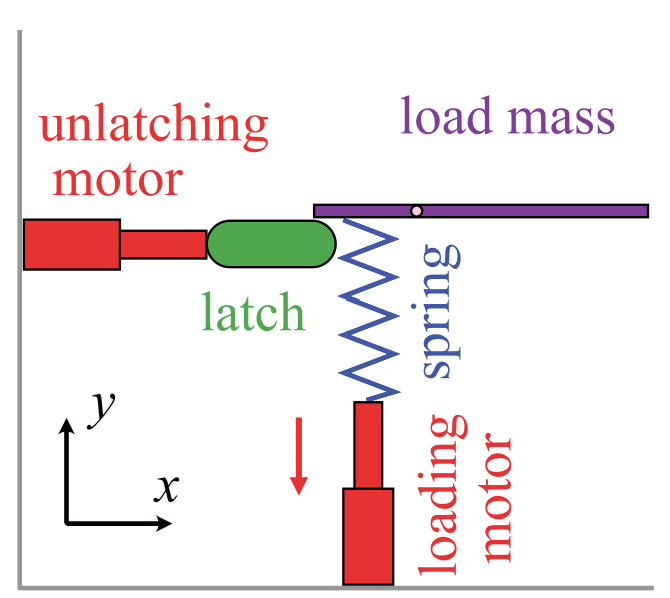We develop a model of latch-mediated spring actuated (LaMSA) systems relevant to comparative biomechanics and bioinspired design. The model contains five components: two motors (muscles), a spring, a latch, and a load mass. One motor loads the spring to store elastic energy and the second motor subsequently removes the latch, which releases the spring and causes movement of the load mass. We develop freely available software to accompany the model, which provides an extensible framework for simulating LaMSA systems. Output from the simulation includes information from the loading and release phases of motion, which can be used to calculate kinematic performance metrics that are important for biomechanical function. In parallel, we simulate a comparable, directly actuated system that uses the same motor and mass combinations as the LaMSA simulations. By rapidly iterating through biologically relevant input parameters to the model, simulated kinematic performance differences between LaMSA and directly actuated systems can be used to explore the evolutionary dynamics of biological LaMSA systems and uncover design principles for bioinspired LaMSA systems. As proof of principle of this concept, we compare a LaMSA simulation to a directly actuated simulation that includes either a Hill-type force-velocity trade-off or muscle activation dynamics, or both. For the biologically-relevant range of parameters explored, we find that the muscle force velocity trade-off and muscle activation have similar effects on directly actuated performance. Including both of these dynamic muscle properties increases the accelerated mass range where a LaMSA system outperforms a directly actuated one.
The ultrafast snap of a finger is mediated by skin friction
The snap of a finger has been used as a form of communication and music for millennia across human cultures. However, a systematic analysis of the dynamics of this rapid motion has not yet been performed. Using high-speed imaging and force sensors, we analyse the dynamics of the finger snap. We discover that the finger snap achieves peak angular accelerations of 1.6 × 106° s−2 in 7 ms, making it one of the fastest recorded angular accelerations the human body produces (exceeding professional baseball pitches). Our analysis reveals the central role of skin friction in mediating the snap dynamics by acting as a latch to control the resulting high velocities and accelerations. We evaluate the role of this frictional latch experimentally, by covering the thumb and middle finger with different materials to produce different friction coefficients and varying compressibility. In doing so, we reveal that the compressible, frictional latch of the finger pads likely operates in a regime optimally tuned for both friction and compression. We also develop a soft, compressible friction-based latch-mediated spring actuated model to further elucidate the key role of friction and how it interacts with a compressible latch. Our mathematical model reveals that friction plays a dual role in the finger snap, both aiding in force loading and energy storage while hindering energy release. Our work reveals how friction between surfaces can be harnessed as a tunable latch system and provides design insight towards the frictional complexity in many robotic and ultra-fast energy-release structures.
Latch-based control of energy output in spring actuated systems
The inherent force–velocity trade-off of muscles and motors can be overcome by instead loading and releasing energy in springs to power extreme movements. A key component of this paradigm is the latch that mediates the release of spring energy to power the motion. Latches have traditionally been considered as switches; they maintain spring compression in one state and allow the spring to release energy without constraint in the other. Using a mathematical model of a simplified contact latch, we reproduce this instantaneous release behaviour and also demonstrate that changing latch parameters (latch release velocity and radius) can reduce and delay the energy released by the spring. We identify a critical threshold between instantaneous and delayed release that depends on the latch, spring, and mass of the system. Systems with stiff springs and small mass can attain a wide range of output performance, including instantaneous behaviour, by changing latch release velocity. We validate this model in both a physical experiment as well as with data from the Dracula ant, Mystrium camillae, and propose that latch release velocity can be used in both engineering and biological systems to control energy output.



